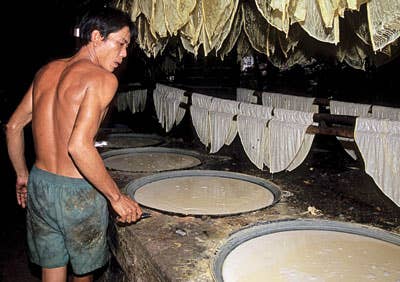
The diverse pleasures of an ancient vegetarian food
"Yuba provides the sustenance for our lives." That was the gist of the lecture from a crimson-robed monk as he narrated our multicourse tofu-skin lunch at the ancient Enryaku-ji Buddhist temple atop sacred Mount Hiei, outside of Kyoto, Japan. The temple's vegetarian diet centers on the delicate film that forms atop soy milk as it heats. That film, so closely associated with monastic cuisine, is what the Japanese call yuba. It's a food that can take many guises, from an ingredient in a light salad to a protein substitute in a vegetarian version of a staple meat dish like roast duck.
Enryaku-ji's yuba arrives fresh daily from Mount Hiei Yuba, a 71-year-old shop in the town of Otsu, where, in a process that has remained virtually unchanged since Chinese monks introduced it to Japan ten centuries ago, soybeans are soaked in freshwater, then ground and strained to produce milk. As the milk is steam-heated to 190°, strands of denatured protein entangle at the surface, trapping molecules of fat to make a durable, delicious film. It takes about ten minutes for the yuba to form. Workers pull the skin back by hand and insert a stainless steel rod under one edge to lift the yuba off the surface of the liquid in an even sheet. The sheets are hung to cool and dry before being packaged fresh, or are hung longer to be sold as dried yuba, which is used, among other things, for vegetarian mock duck.
Both are made in the U.S., too, and are available in Asian markets. Preparations I've enjoyed in America include a salad of yuba, pickled cabbage, scrambled eggs, and bok choy from Manhattan's City Bakery and a spicy, garlicky stir-fry of yuba and fresh soybeans (see recipe below).
At our temple lunch, the dishes ranged from silky yuba sashimi with ponzu sauce and thin strips of yuba in miso soup to yuba-wrapper dumplings stuffed with seasoned tofu, green garlic, and ginger. The yuba's versatility was impressive, but it was the clean, sweet, milky soybean taste that was most striking.
Keep Reading
Continue to Next Story










